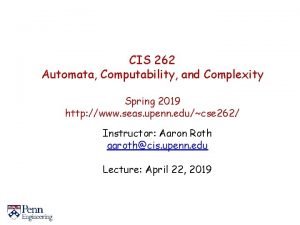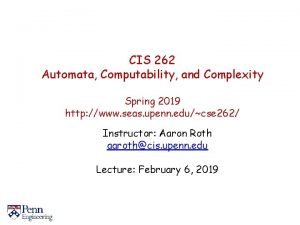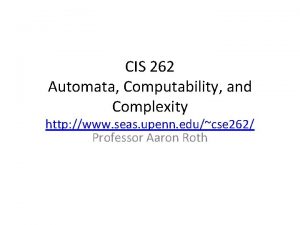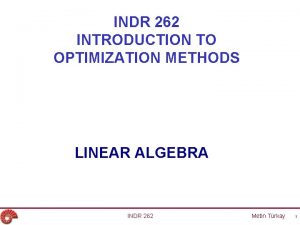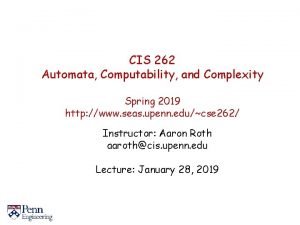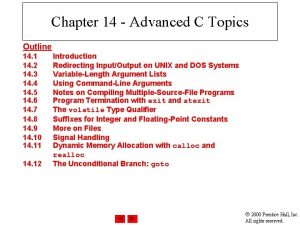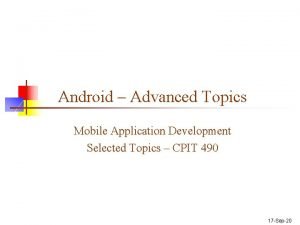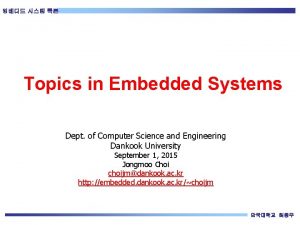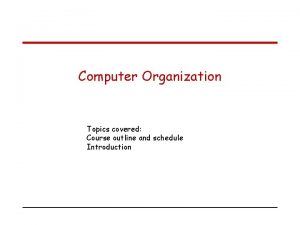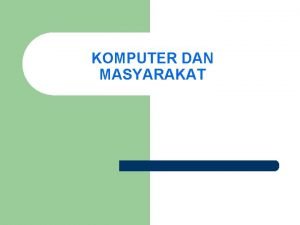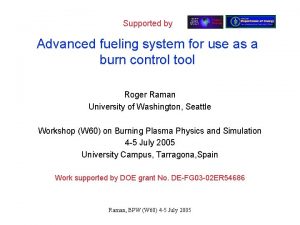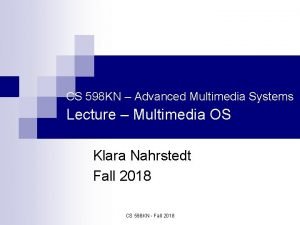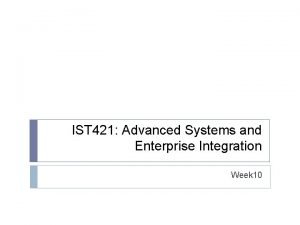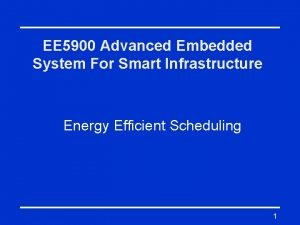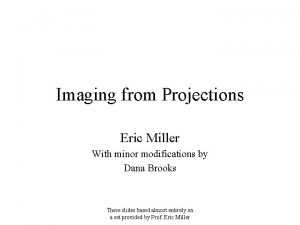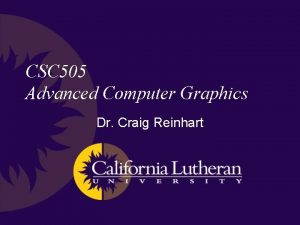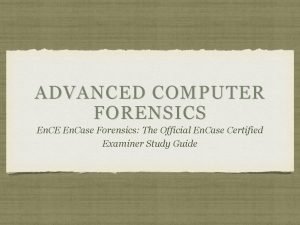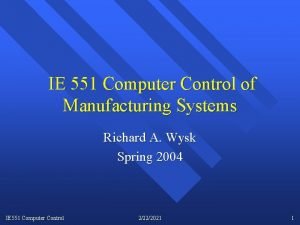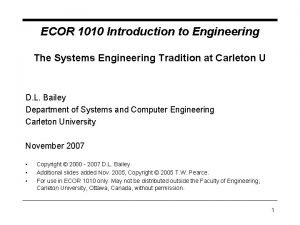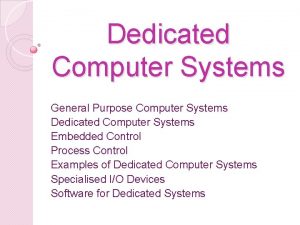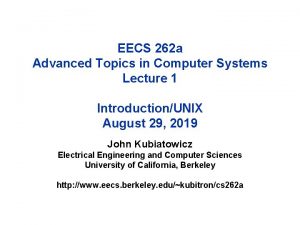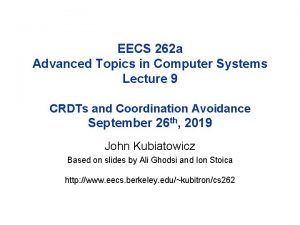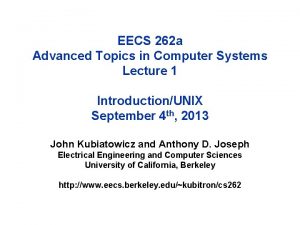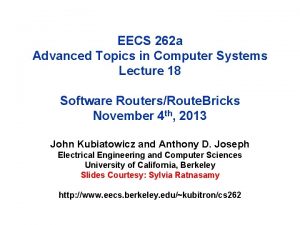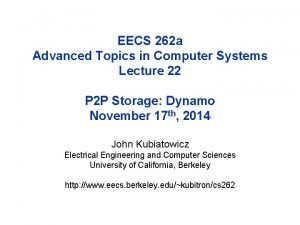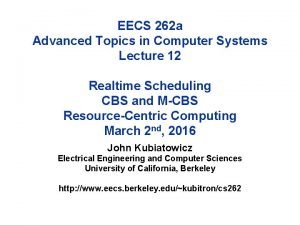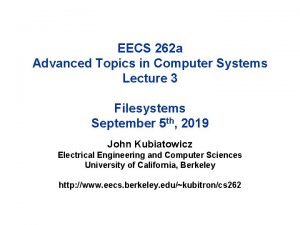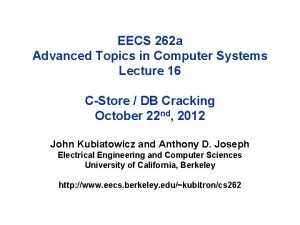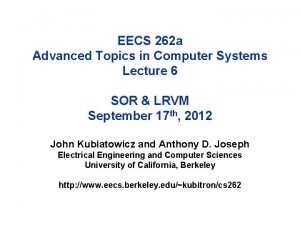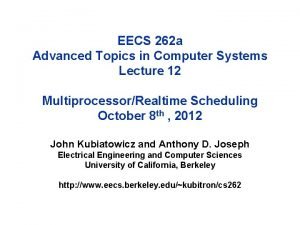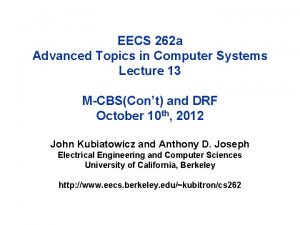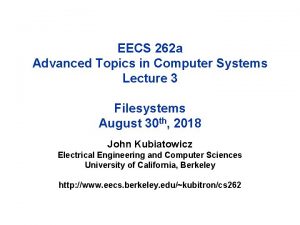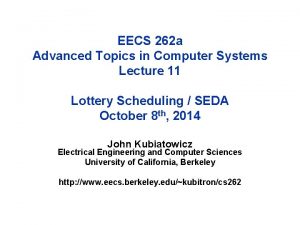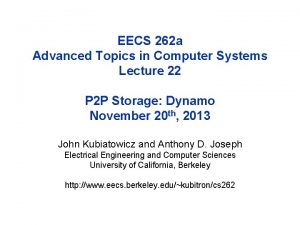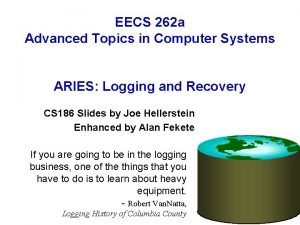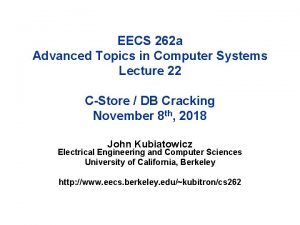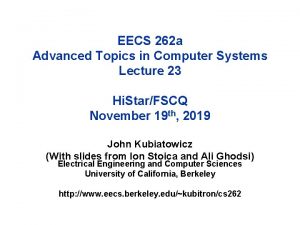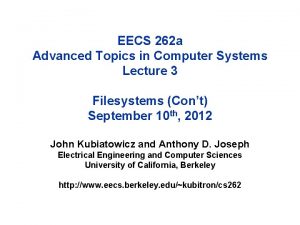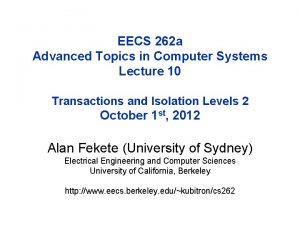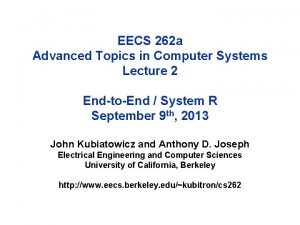EECS 262 a Advanced Topics in Computer Systems




































- Slides: 36

EECS 262 a Advanced Topics in Computer Systems Lecture 8 Transactional Flash & Rethink the Sync February 17 th, 2016 John Kubiatowicz Electrical Engineering and Computer Sciences University of California, Berkeley http: //www. eecs. berkeley. edu/~kubitron/cs 262

Today’s Papers • Transactional Flash Vijayan Prabhakaran, Thomas L. Rodeheffer, and Lidong Zhou. Appears in Proceedings of the 8 th USENIX Conference on Operating Systems Design and Implementation (OSDI 2008). • Rethink the Sync Edmund B. Nightingale, Kaushik Veeraraghavan, Peter M. Chen, and Jason Flinn. Appears in Proceedings of the 7 th USENIX Conference on Operating Systems Design and Implementation (OSDI 2006). • Thoughts? 2/17/2016 cs 262 a-S 16 Lecture-08 2

FLASH Memory Samsung 2015: 512 GB, NAND Flash • Like a normal transistor but: – Has a floating gate that can hold charge – To write: raise or lower wordline high enough to cause charges to tunnel – To read: turn on wordline as if normal transistor » presence of charge changes threshold and thus measured current • Two varieties: – NAND: denser, must be read and written in blocks – NOR: much less dense, fast to read and write • V-NAND: 3 D stacking (Samsung claims 1 TB possible in 1 chip) 2/17/2016 cs 262 a-S 16 Lecture-08 3

Flash Memory (Con’t) • Data read and written in page-sized chunks (e. g. 4 K) – Cannot be addressed at byte level – Random access at block level for reads (no locality advantage) – Writing of new blocks handled in order (kinda like a log) • Before writing, must be erased (256 K block at a time) – Requires free-list management – CANNOT write over existing block (Copy-on-Write is normal case) 2/17/2016 cs 262 a-S 16 Lecture-08 4

Flash Details • Program/Erase (PE) Wear – – Permanent damage to gate oxide at each flash cell Caused by high program/erase voltages Issues: trapped charges, premature leakage of charge Need to balance how frequently cells written: “Wear Leveling” • Flash Translation Layer (FTL) – Translates between Logical Block Addresses (at OS level) and Physical Flash Page Addresses – Manages the wear and erasure state of blocks and pages – Tracks which blocks are garbage but not erased • Management Process (Firmware) – Keep freelist full, Manage mapping, Track wear state of pages – Copy good pages out of basically empty blocks before erasure • Meta-Data per page: – ECC for data – Wear State – Other Stuff!: Capitalized on by this paper! 2/17/2016 cs 262 a-S 16 Lecture-08 5

Phase Change memory (IBM, Samsung, Intel) • Phase Change Memory (called PRAM or PCM) – Chalcogenide material can change from amorphous to crystalline state with application of heat – Two states have very different resistive properties – Similar to material used in CD-RW process • Exciting alternative to FLASH – Higher speed – May be easy to integrate with CMOS processes 2/17/2016 cs 262 a-S 16 Lecture-08 6

Goals of paper • Provide a hardware Transactional model: – Write. Atomic(p 1, p 2, p 3, …, pn) – Interfering Reads not tracked – Transactions can be aborted before commited • Provides: – Atomicity (All or nothing) – Isolation (Different transactions do not interfere) – Durability (After commit, data will survive crashes • Target: file systems/databases – Provides a native implementation for durable log – However – provides its semantics without using a log (using linked metadata as the “log”) • Properties of Flash that is good for Tx. Flash: – Copy on Write is natural – Fast random reads (fragmentation of “log-based” system not a problem) – High Concurrency (lots of bandwidth could be exploited) 2/17/2016 cs 262 a-S 16 Lecture-08 7

Peek into Architecture: • Addition of new functionality to firmware – Commit, Garbage Collection, Recovery Logic • Needs about 25% more memory for transaction tracking • Needs different interface than native Disk interface – Write. Atomic, Abort 2/17/2016 cs 262 a-S 16 Lecture-08 8

Simple Cyclic Commit (SCC) • Every flash page has: – Page # (logical page) – Version # (monotonically increasing) – Pointer (called next) to another flash page (Page #, Version#) – Notation: Pj is jth version of page P • Two key sets: – Let S be set of existing records – Let R be set of records pointed at by other records (may not exist) • Cycle Property: – For any intention record r S, r is committed r. next is committed – If there is a complete cycle, then everyone in cycle is committed • SCC Invariant: – If Pj S, any intention record Pi S R with i<j must be committed – Consequence: must erase failed commits before committing new versions of page 2/17/2016 cs 262 a-S 16 Lecture-08 9

Back Pointer Cyclic Commit (BPCC) • Introduce new piece of metadata: backpointer – Points to most recent committed version of same page – Allows clear identification of failed commits by noticing intervening blocks which must be uncommitted • Complexity is all about garbage collection now • Straddler – For any record Pj: existence of Pk with Pk. back = Pi and i < j < k means that Pk straddles Pj – Means Pj is not committed! • BPCC Invariant: – For a highest version intention record Ph S, Let Ql = Ph. next. If there exists a Qk S with k > l and there exists no straddler for Ql, then Ph is committed 2/17/2016 cs 262 a-S 16 Lecture-08 10

Evaluation? • Model Checking of SCC and BPCC protocols – Published elsewhere • Collect Traces from version of Ext 3 (Tx. Ext 3) running on linux with applications – This got them most of the way, but Ext 3 doesn’t really abort much • Synthetic Workload generator to generate a variety of transactions • Flash Simulator – SSD simulator from previous work described elsewhere » Would have to look it up to know full accuracy » Give them benefit of doubt – 32 GB Tx. Flash device with 8 fully-connected 4 GB flash packages – Parameters from Samsung data sheet 2/17/2016 cs 262 a-S 16 Lecture-08 11

Savings from avoidance of commit • Log and data combined together • By avoiding last commit record, have one less write 2/17/2016 cs 262 a-S 16 Lecture-08 12

General throughput results 2/17/2016 cs 262 a-S 16 Lecture-08 13

Is this a good paper? • What were the authors’ goals? • What about the evaluation/metrics? • Did they convince you that this was a good system/approach? • Were there any red-flags? • What mistakes did they make? • Does the system/approach meet the “Test of Time” challenge? • How would you review this paper today? 2/17/2016 cs 262 a-S 16 Lecture-08 14

Break 2/17/2016 cs 262 a-S 16 Lecture-08 15

Facebook Reprise: How to Store Every Photo Forever? • 82% of Facebook traffic goes to 8% of photos – Sequential writes, but random reads – Shingled Magnetic Recording (SMR) HDD with spin-down capability is most suitable and cost-effective technology for cold storage • New Facebook datacenter in Prineville, OR – 3 data halls, each with 744 Open Racks – 1 Open Vault storage unit holds 30 3. 5” 4 TB SMR SATA disks – 1 Open Rack holds 16 OV storage units (16 x 30 drives = 480 drives) – 1 disk rack row has 24 Open Racks (24 x 480 drives = 11, 520 drives) – 1 data hall has 30 disk rack rows (30 x 11, 520 drives = 345, 600 drives) – Using 4 TB SMR drives (4 TB x 345, 600 drives) = 1, 382, 400 TB – 3 data halls = 4. 15 Exa. Bytes of raw capacity!! http: //www. opencompute. org/wp/wp-content/uploads/2013/01/Open_Compute_Project_Cold_Storage_Specification_v 0. 2/17/2016 cs 262 a-S 16 Lecture-08 16

Rethink the Sync: Premise (Slides borrowed from Nightingale) • Asynchronous I/O is a poor abstraction for: – – Reliability Ordering Durability Ease of programming • Synchronous I/O is superior but 100 x slower – Caller blocked until operation is complete • New model for synchronous I/O: External Synchrony – Synchronous I/O can be fast! – Same guarantees as synchronous I/O – Only 8% slower than asynchronous I/O 2/17/2016 cs 262 a-S 16 Lecture-08 17

When a sync() is really async • On sync() data written only to volatile cache – 10 x performance penalty and data NOT safe Disk Operating System n Volatile Cache Cylinders 100 x slower than asynchronous I/O if disable cache 2/17/2016 cs 262 a-S 16 Lecture-08 18

To whom are guarantees provided? • Synchronous I/O definition: – Caller blocked until operation completes App App OS Kernel Disk n 2/17/2016 Screen Network Guarantee provided to application cs 262 a-S 16 Lecture-08 19

To whom are guarantees provided? App App OS Kernel Disk Screen Network • Guarantee really provided to the user 2/17/2016 cs 262 a-S 16 Lecture-08 20

Providing the user a guarantee • User observes operation has completed – User may examine screen, network, disk… • Guarantee provided by synchronous I/O – Data durable when operation observed to complete • To observe output it must be externally visible – Visible on external device 2/17/2016 cs 262 a-S 16 Lecture-08 21

Why do applications block? External App OS Kernel Internal External App Disk Screen Network • Since application external we block on syscall n Application is internal: no need to block! 2/17/2016 cs 262 a-S 16 Lecture-08 22

A new model of synchronous I/O • Provide guarantee directly to user – Rather than via application • Called externally synchronous I/O – Indistinguishable from traditional sync I/O – Approaches speed of asynchronous I/O 2/17/2016 cs 262 a-S 16 Lecture-08 23

Example: Synchronous I/O Application blocks 101 write(buf_1); Application blocks 102 write(buf_2); 103 print(“work done”); 104 foo(); % %work done % Process 2/17/2016 TEXT OS Kernel cs 262 a-S 16 Lecture-08 Disk 24

Observing synchronous I/O 101 write(buf_1); 102 write(buf_2); Depends on 1 st write 103 print(“work done”); Depends on 1 st & 2 nd write 104 foo(); • Sync I/O externalizes output based on causal ordering – Enforces causal ordering by blocking an application • Ext sync: Same causal ordering without blocking applications 2/17/2016 cs 262 a-S 16 Lecture-08 25

Example: External synchrony 101 write(buf_1); 102 write(buf_2); 103 print(“work done”); 104 foo(); % %work done % Process 2/17/2016 TEXT OS Kernel cs 262 a-S 16 Lecture-08 Disk 26

Tracking causal dependencies • Applications may communicate via IPC – Socket, pipe, fifo etc. • Need to propagate dependencies through IPC • Authors build upon Speculator [SOSP ’ 05] – Track and propagate causal dependencies – Buffer output to screen and network – Targeted at improving performance when network is involved » (Such as for a Network File System) – Return immediately with speculative result » Checkpoint processes, restore checkpoint if real result doesn’t match speculated result • Pieces of Speculator useful here: – Tracking of dependencies to make sure that we maintain property of External Synchrony • I’ve put up the SOSP 2005 paper as an optional reading 2/17/2016 cs 262 a-S 16 Lecture-08 27

Tracking causal dependencies Process 1 Process 2 101 write(file 1); 101 print (“hello”); 102 do_something(); 102 read(file 1); 103 print(“world”); %hello % % world Process 2 TEXT Commit Dep 1 OS Kernel Process 1 2/17/2016 Disk cs 262 a-S 16 Lecture-08 28

Output triggered commits • Maximize throughput until output buffered • When output buffered, trigger commit – Minimize latency only when important % %work done % Process 2/17/2016 TEXT OS Kernel cs 262 a-S 16 Lecture-08 Disk 29

Evaluation • Implemented ext sync file system Xsyncfs – Based on the ext 3 file system – Use journaling to preserve order of writes – Use write barriers to flush volatile cache • Compare Xsyncfs to 3 other file systems – Default asynchronous ext 3 – Default synchronous ext 3 – Synchronous ext 3 with write barriers 2/17/2016 cs 262 a-S 16 Lecture-08 30

When is data safe? File System Configuration Data durable on write() Data durable on fsync() Asynchronous No Not on power failure Synchronous w/ write barriers Yes External synchrony Yes 2/17/2016 cs 262 a-S 16 Lecture-08 31

Postmark benchmark n Xsyncfs within 7% of ext 3 mounted asynchronously 2/17/2016 cs 262 a-S 16 Lecture-08 32

The My. SQL benchmark n Xsyncfs can group commit from a single client 2/17/2016 cs 262 a-S 16 Lecture-08 33

Specweb 99 throughput n Xsyncfs within 8% of ext 3 mounted asynchronously 2/17/2016 cs 262 a-S 16 Lecture-08 34

Specweb 99 latency n Request size ext 3 -async xsyncfs 0 -1 KB 0. 064 seconds 0. 097 seconds 1 -10 KB 0. 150 second 0. 180 seconds 10 -100 KB 1. 084 seconds 1. 094 seconds 100 -1000 KB 10. 253 seconds 10. 072 seconds Xsyncfs adds no more than 33 ms of delay 2/17/2016 cs 262 a-S 16 Lecture-08 35

Is this a good paper? • What were the authors’ goals? • What about the evaluation/metrics? • Did they convince you that this was a good system/approach? • Were there any red-flags? • What mistakes did they make? • Does the system/approach meet the “Test of Time” challenge? • How would you review this paper today? 2/17/2016 cs 262 a-S 16 Lecture-08 36
 Advanced topics in computer science
Advanced topics in computer science Cis262
Cis262 Cis 262 upenn
Cis 262 upenn Cis262
Cis262 Indr 262
Indr 262 Cis 262
Cis 262 Uiuc cs 527
Uiuc cs 527 Angular guard naming convention
Angular guard naming convention Angular advanced topics
Angular advanced topics Advanced c topics
Advanced c topics Advanced topics in web development
Advanced topics in web development Android advanced topics
Android advanced topics Embedded systems topics for presentation
Embedded systems topics for presentation Computer organization topics
Computer organization topics Computer and society topics
Computer and society topics Nnemp
Nnemp Advanced fueling systems
Advanced fueling systems Advanced multimedia systems
Advanced multimedia systems Marine fluid systems
Marine fluid systems Tom kilcer advanced ag systems
Tom kilcer advanced ag systems Advanced systems integration
Advanced systems integration Advanced embedded systems
Advanced embedded systems Enotes fst
Enotes fst Advanced cooling systems inc
Advanced cooling systems inc Fundamentals of cpu in advanced computer architecture
Fundamentals of cpu in advanced computer architecture Advanced computer graphics
Advanced computer graphics Advanced computer forensics
Advanced computer forensics Fastbloc se
Fastbloc se Decision support systems and intelligent systems
Decision support systems and intelligent systems Engineering elegant systems: theory of systems engineering
Engineering elegant systems: theory of systems engineering Embedded systems vs cyber physical systems
Embedded systems vs cyber physical systems Engineering elegant systems: theory of systems engineering
Engineering elegant systems: theory of systems engineering Computer control of manufacturing systems
Computer control of manufacturing systems Ecor 1010
Ecor 1010 Dedicated system examples
Dedicated system examples Computer networks vs distributed systems
Computer networks vs distributed systems Motion specification in computer graphics
Motion specification in computer graphics

